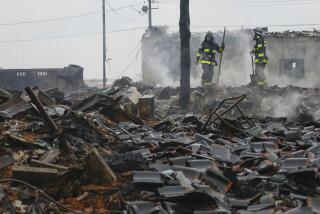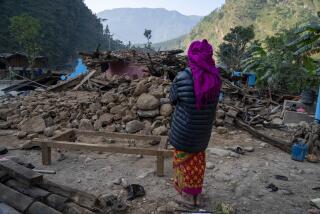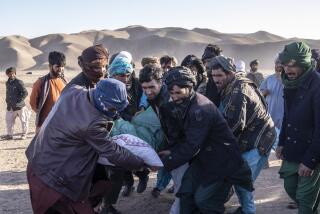Villagersâ Lives and Livelihoods in Tatters
DHAMADKA, India â The only homes left in this village are makeshift shelters with walls of the lovely indigo and burgundy cloth that has been this villageâs lifeblood for generations.
There were about 250 houses in Dhamadka in western Indiaâs Gujarat state before most of their cinder-block walls cracked and shattered like glass in a matter of seconds during Fridayâs magnitude 7.9 earthquake. The few buildings still standing are too badly damaged to live in.
The 2,500 villagers were relatively well off compared with millions of others in rural India because most of Dhamadkaâs families made a living from an ancient craft that has won new admirers among the rich and fashionable in the West.
They carved beautiful patterns into small pieces of teak and used the blocks to print cotton cloth with dyes mixed from fruits, roots and mineral powders, following formulas handed down from fathers to sons through the centuries.
Most of the craftsmenâs wares, which drew buyers from Europe and North America, were ruined in the quake along with their workshops and houses. Some villagers have hung the soiled cloth from sticks to make new homes, creating a striking beauty among the ruins.
Elsewhere, stacks of the bright material have spilled out of their confines and now drape the debris, lifting in the breeze.
From experience, the residents expect emergency relief workers to stop visiting with donations of clothes and food after another week or two, and any government promises of reconstruction aid to get bogged down in the morass of Indian bureaucracy and corruption.
It will be two years before Dhamadkaâs homes and workshops are rebuilt and functioning again, villager Ismail Mohammed Khatri predicted. In the meantime, most of its people will be dependent on charity and government aid, he said.
Last weekâs quake killed 115 people in Dhamadka, including Khatriâs mother, Fatima, 70, and his 15-year-old daughter, Hafsha, who were crushed by a collapsing wall.
âIt had to happen. Thatâs why it happened. But we want to start work as soon as we can,â said Khatri, 40, a Muslim who believes that it was Godâs will that his village be destroyed, and that his mother and daughter die.
âWhen God has given me so many difficulties,â he said, âhe has made my heart strong too.â
Khatri is a master of a craft that goes back nine generations in his family, but he learned more than the secrets of mixing dyes and printing azarakh cloth from his late father, Mohammadbhai Siddikbhai Khatri.
Mohammadbhai, who died in 1999, built a foreign market for his villageâs cloth.
He traveled as far as the United States to show textile experts his skills. On one of those trips, Mayor F. Paul Goodland of Ames, Iowa, granted Mohammadbhai honorary citizenship. The framed proclamation hung on Khatriâs wall until Fridayâs quake smashed it to pieces.
Khatri learned from his father that such trophies last only as long as God wills them. His father had lived through ruin too, in the earthquake of 1956, the last time Dhamadka was leveled.
Back then, the Rama Krishna Mission, a large national charity, rebuilt all the houses in the mixed village of Hindus and Muslims, but the village wasnât whole again until 1958.
Times have changed, and Dhamadkaâs people will probably have to take out government loans to pay for reconstruction, Khatri said.
âMy credit is very good, so I can get goods from my suppliers,â said Khatri, who exports his finest cloth to Britain, Spain and Canada. âBut these others will need 100% help. Itâs not a question of low interest.
âJust any interest is a problem. And corrupted officials are a problem too.â
The United Nations estimates that 200,000 people were left homeless after Friday morningâs quake in Gujarat, U.N. Undersecretary-General Kenzo Oshima said in New York.
By Wednesday, 12,000 bodies had been pulled from the debris. The final death toll could reach 25,000, said Haren Pandya, Gujaratâs home minister.
Rescuers found at least three more people alive in the rubble Wednesday, including a 12-year-old girl discovered by an Indian army rescue team in the town of Bhuj, near the epicenter.
But five days after the devastating quake, rescuers were giving way to demolition crews, who set plastic explosives to bring down precariously balanced buildings before the continuing aftershocks could topple them and kill more people.
The federal and state governments havenât announced details of any reconstruction plans. But the recovery efforts after other recent disasters, such as the 1999 cyclone in eastern Orissa state, which left several hundred thousand homeless, were based on government grants to the poor and low-interest loans to others.
About 250,000 victims of the Orissa cyclone received such loans from the government, with a grace period before the start of repayments, said Bhaskar Barua, Indiaâs agriculture secretary.
India is likely to turn to the World Bank and the Asian Development Bank to help pay for the reconstruction, Barua said in a telephone interview from New Delhi, the capital. Estimates of the damage from the quake run as high as $5.5 billion.
It costs about $2,150 to build a house in Dhamadka, almost three yearsâ wages for the families that live there. And most villagers will earn nothing for at least the next year, Khatri said.
By comparison, he and his brother Abdul Razzaque--a national award winner for his work--are rich men. They take in slightly more than $43,000 a year, but after paying 16 workers and covering other costs, Khatri said, he and his two brothers are left with a profit of only $2,150 to feed a family of 27.
His main workshop is a ruin, and it will take at least half a year to get a new one operating, he said.
Around the corner, Omar Khadder, 90, lay on an old steel-framed bed in front of his familyâs destroyed house, mumbling incoherently.
Khadder, who was a cloth printer for 20 years, retired five years ago. He, his son and daughter-in-law lost what little they had in the quake, said neighbor Abdul Rahim.
âHeâs got a lot of difficulties,â Rahim said, âbut he shouts Godâs name--âAllah! Allah!â--especially at night.â
Khadderâs dirty white shirt was spattered with red. In a better time, it might have been one of the villageâs richest natural dyes. Instead, it was his own dried blood, from a bad cut on his ear and forehead.
(BEGIN TEXT OF INFOBOX / INFOGRAPHIC)
How to Help
These agencies are among the many accepting contributions for assistance to victims of the earthquake in South Asia.
American Jewish World Service
989 Ave. of the Americas
New York, NY 10018
(800) 889-7146
https://www.ajws.org
Concern Worldwide
104 E. 40th St., Room 903
New York, NY 10016
(212) 557-8000
https://www.concernusa.org
Church World Service
P.O. Box 968
Elkhart, IN 46515
(800) 297-1516
https://www.churchworldservice.org
Relief International
11965 Venice Blvd., Suite 405
Los Angeles, CA 90066
(310) 572-7770
https://www.ri.org
Salvation Army World Service Office
Mark donations
âIndia Earthquakeâ
P.O. Box 269
Alexandria, VA 22313
(703) 684-5528
https://www.salvationarmyusa.org
U.S. Fund for UNICEF
333 E. 38th St.
New York, NY 10016
(800) FOR-KIDS
https://www.unicefusa.org
More to Read
Sign up for Essential California
The most important California stories and recommendations in your inbox every morning.
You may occasionally receive promotional content from the Los Angeles Times.









